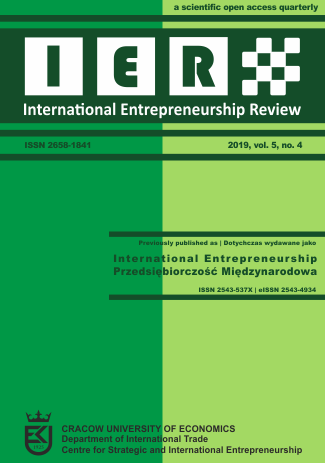The financing structure of companies of the Visegrad Group countries in the years 2005-2014

Abstract
Objective: The main aim of the article is to compare the financing structure of companies of the Visegrad Group countries in the years 2005-2014, that is in the period before, during and after the global financial crisis.
Research Design & Methods: The paper investigates the structure of financing enterprises operating in the Visegrad Group countries in the years 2005-2014. In the analysis several financial ratios were calculated and analysed, presenting the capital structure and sources of financing companies.
Findings: In spite of the fact that the overall level of debt differs in analysed countries, trends in the shaping of the share of debt ratio were similar in individual countries. The strongest relationship between the ratios concerning enterprises in individual countries was observed in the analysis of the share of financial surplus of the firms and the scope of use of trade liabilities. The weakest in the level of financing with bank credits (long-term and short-term).
Contribution & Value Added: Research into determinants of the financing structure of companies takes a number of factors into consideration, among which the condition of economy is undoubtedly important. Therefore the research included in the paper follows changes in companies’ financing structure in the aspect of a financial crisis. Additional a detailed comparative analysis was conducted concerning the financing structure of the Visegrad Group countries.
Keywords
capital structure, determinant of capital structure, debt ratio, bank credits, self-financing, financial crisis
Author Biography
Katarzyna Łach
Assistant professor, PhD in economics. Working at the Department of Corporate Finance, Cracow University of Economics (Poland). Her research interests focus on financial structure, sources of financing of enterprises and behavioural corporate finance.
References
- Adamiec, J. (Ed.) (2009). Kryzys finansowy. Wybrane zagadnienia. Warszawa: Biuro Analiz Sejmowych.
- Amadeus – European Company Data. Retrieved from https://amadeus.bvdinfo.com/ on October 15, 2019.
- Antczak, R. & Starczewska-Krzysztoszek, M. (2009). Monitoring kondycji sektora dużych przedsiębiorstw 2009. Warszawa: PKPP Lewiatan i Deloitte. http://konfederacjalewiatan.pl/upload/File/2009%2003/Badanie%20duzych%20firm_090402_final.pdf
- Fan, J.P.H., Titman, S. & Twite, G. (2012). An international comparison of capital structure and debt maturity choices. Journal of Financial and Quantitative Analysis, 47, 23-56.
- Grabia, T. (2014). Sytuacja gospodarcza w krajach Grupy Wyszehradzkiej – analiza porównawcza, Gospodarka w Praktyce i Teorii, 2(35), 35-47.
- Gryko, J.M. (2013). Znaczenie elastyczności finansowej przedsiębiorstwa w czasie globalnego kryzysu. Zarządzanie i Finanse, 11(2), 123-134.
- Iwin-Garzyńska, J. (2010). Kredyt bankowy w strukturze finansowania polskich przedsiębiorstw a kryzys finansowy. Finanse, Rynki Finansowe, Ubezpieczenia, 39(646), 37-50.
- Kaliszczak, L., & Urban, L. (2011). Zachowania małych i średnich przedsiębiorstw w warunkach spowolnienia gospodarczego w Polsce. In: M.G. Woźniak (ed.) Nierówności społeczne a wzrost gospodarczy. Uwarunkowania sprawnego działania w przedsiębiorstwie i regionie. Rzeszów: University of Rzeszów, 187-201.
- Leicht, A. (2011). Dostęp do kredytów bankowych dla przedsiębiorstw, w krajach Europy Południowo- Wschodniej podczas międzynarodowego kryzysu finansowego („Materiały i Studia”, nr 260). Warszawa: National Bank of Poland.
- Lisińska, K. (2015). Determinanty struktury kapitału na poziomie państwa na podstawie przeglądu literatury. Prace Naukowe Uniwersytetu Ekonomicznego we Wrocławiu, 412, 204-215.
- Marzec, J. & Pawłowska, M. (2011). Racjonowanie kredytów a substytucja między kredytem kupieckim i bankowym – badania na przykładzie polskich przedsiębiorstw („Materiały i Studia”, nr 261). Warszawa: National Bank of Poland.
- Maślanka, T. (2007). Dylematy memoriałowego pomiaru rentowności. In A. Bogus & M. Wypych, (Eds.). Harmonizacja rynków finansowych i finansów przedsiębiorstw w skali narodowej i europejskiej. Warszawa: Difin, 520-530.
- Maślanka, T. (2012). Wartości krytyczne wybranych wskaźników analizy finansowej – wnioski z badań nad upadłością przedsiębiorstw notowanych na GPW w Warszawie w latach 2000-2011. In S. Owsiak (Ed.), Stabilność systemu finansowego warunkiem rozwoju gospodarczego, Tom II. Bielsko-Biała: The Bielsko-Biała School of Finance and Law, 206-219.
- Ostrowska, D., & Cymek, M. (2012). Stan finansowania działalności przedsiębiorstw w okresie kryzysu. Gazeta Finansowa.
- PKPP Lewiatan (2011). Indeks Biznesu PKPP Lewiatan. August 2009 – March 2011. Retrieved from http://pkpplewiatan.pl/ on October 15, 2019.
